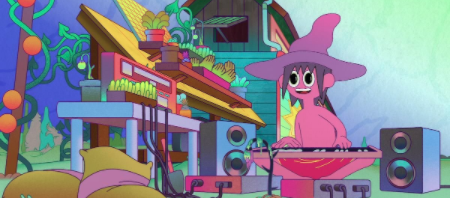Yes, this post will have some spoilers, so if you’re sensitive about these things, just go watch The Midnight Gospel and come back later. It’s just 8 episodes anyway.
So, of course, nowadays everybody’s inside basically. With the whole pandemic going on out there the best thing we can all do is stay inside. Thankfully, Pendleton Ward has just released a new animated show on Netflix, based on a collaboration with comedian Duncan Trussell. Thankfully, because for some reason Netflix decided to butcher Adventure Time, only including up to season 6, omitting season 4, and omitting certain key episodes of the later seasons (which are also presented in an almost aleatoric order). Also, they are going to remove Over the Garden Wall from their catalogue, if they haven’t done so already.
The premise of the show is this: Clancy (voiced by Duncan) is a spacecaster, basically a podcaster but this time the interviews he does go into space because he lives in the future. He owns an illegal parallel universe generator, which he uses to find new characters to interview about the most various topics, from the use of marihuana to death to the meaning of spirituality in the modern world. Each of these characters he finds are living in worlds that are dying one way or another, so we get to experience very different kinds of apocalypses while listening to these conversations. The recorded conversations, by the way, come from Duncan’s actual podcast, The Duncan Trussell Family Hour, which I totally recommend listening after you finished the series.
The look of the show has been described as following a stoner aesthetic: extremely psychedelic, bright colors, flowing forms, extreme violence in some episodes, and absurd sci fi backgrounds. Added to the topics they talk about, you don’t need weed to get high on this show, believe me. I haven’t done it myself, but I’m sure it’s a great show to get high to anyway. The music is by several different artists, and it even includes some of Duncan’s own creations.
Now, what I personally found extremely interesting is the apparent disconnection that exists between the visual action on each episode and the topic and flow of the dialogue. It is clear that there are some extra scripted moments added to help the narrative of the episode, but apart from that, the rest of the dialogue is basically the interview Duncan has had with different people.
In some episodes it is very extreme, for example in the first one, which is based on an interview with Drew Pinsky, a media personality and addiction specialist, about the potential in the use of psychedelic drugs and the importance of creating a culture of education and awareness around them. The setting, however, is quite far away from what you would imagine. Drew’s voice becomes personified in the tiny president of the US (in the episode known as Glasses Man) during a zombie invasion. They meet in front of the White House, where Clancy happened to fall on top of him after being transported from his own dimension, and they soon begin roaming the streets of Washington, all the while Glasses Man is killing zombies with his shotgun. This is not even the most violent episode of the series, by the way, wait until episode 2, or 5.
In other episodes, the relationship between the subject of the conversation and the action is quite clear, like when Clancy interviews Death in episode 7, which is voiced by Caitlin Doughty, a youtuber and advocate for death acceptance. Still, in this episode, there is a whole plot developing behind the dialogue, and sometimes it is genuinely difficult to follow both things at the same time.
While many people might find that annoying (I must say I myself questioned the choice of having so much plot behind such a dense interview), the effect this has on our perception of the whole is quite interesting. I found myself more often than not trying to find connections between the two things, and was surprised to find many ways in which image and text corresponded to each other.
This technique of superimposing two seemingly unrelated elements in order to create a new whole is called by many counterpoint, which originates from the Renaissance technique of writing music made up of independent and yet interrelated melodic layers. During the 20th century, the notion of what music is, and what art is in general, came, as we know, into question, and therefore also how and if these ancient techniques could become relevant in the modern world. Cristiano Melli, a composer and a dear friend of mine, told me about a Gilius van Bergeijk, a Dutch composer who used to teach at the Royal Conservatoire in the Hague. He used to define counterpoint exactly as (and I paraphrase) the result of two or more things that come together to for a new thing. This is very general, and is intended to be so, because for him it could literally be anything.
Ben Zijlstra, a teacher at the Dutch Film Academy, in his booklet accompanying his lectures about sound in film (which I was lucky enough to follow during my studies in Amsterdam), laments that this counterpoint technique, which used to be present in many early experimental films (he mentions soviet filmmaker Sergei Einsenstein’s films), has currently been mostly abandoned. I think it is in shows like this, especially in cartoon shows, that these experimental techniques are making a very strong comeback.
Have you watched the show? What are your opinions about it? I’m very curious to know!
image source here
